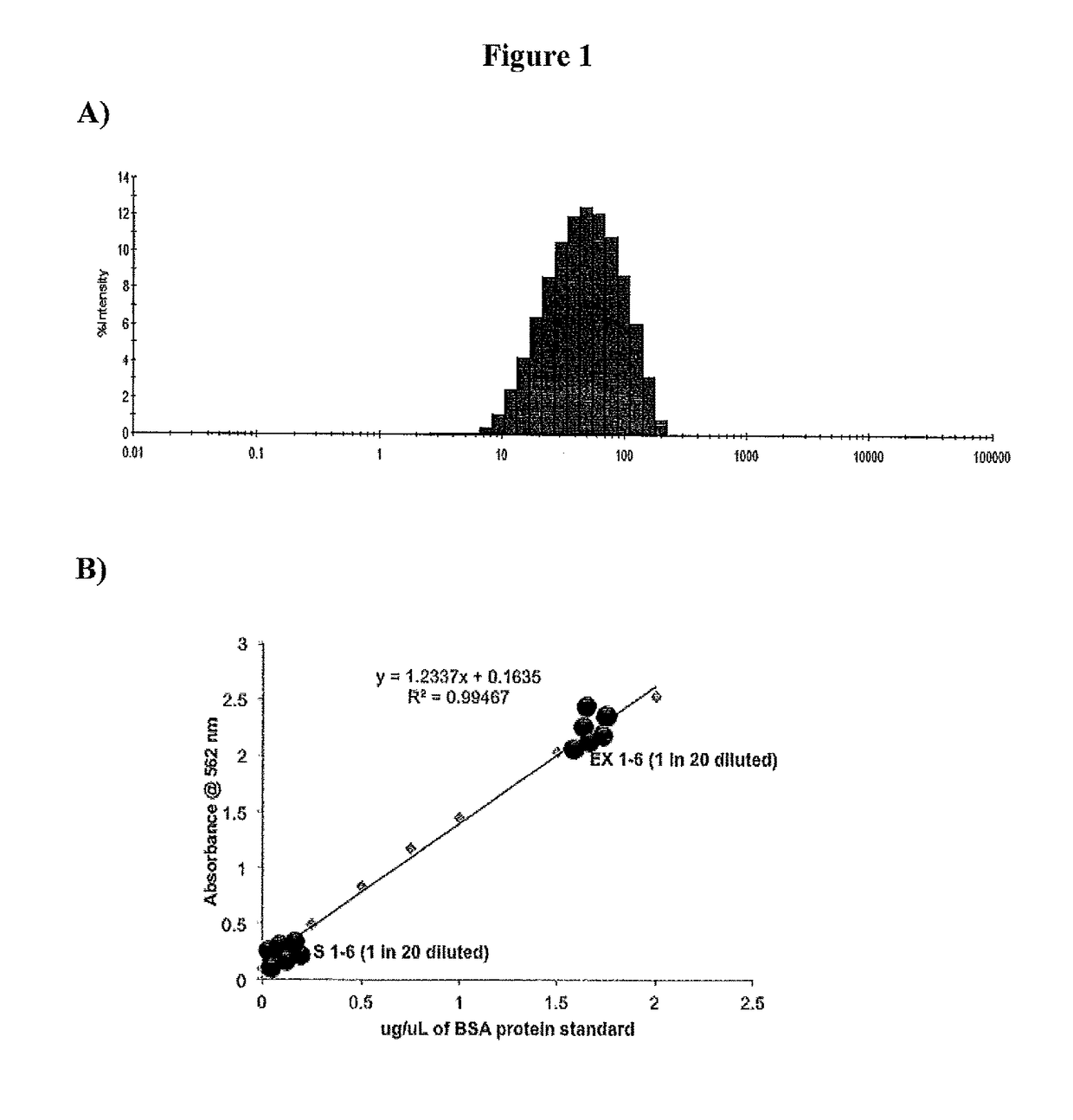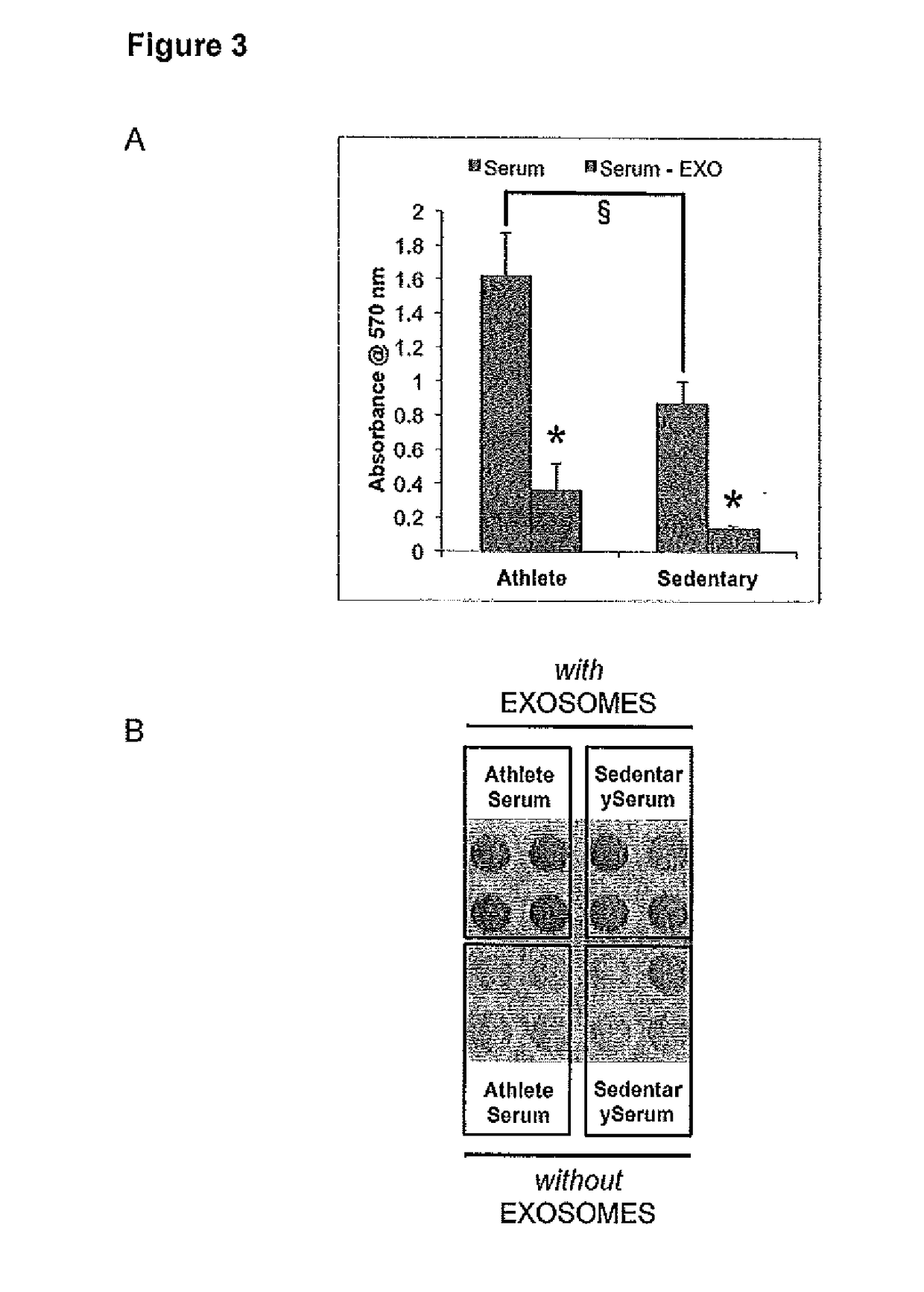Exersomes, methods of producing and method of using
a technology of exersomes and elastomers, applied in the field of exosomes, can solve the problems of insufficient prevention of negative effects, insufficient preventing of negative effects, and insufficient elucidation of biological mediators of the multi-systemic benefits conferred by physical activity
- Summary
- Abstract
- Description
- Claims
- Application Information
AI Technical Summary
Benefits of technology
Problems solved by technology
Method used
Image
Examples
example 1
of Exosomes
[0069]Blood and urine samples were collected from healthy human subjects. For serum isolation, blood was allowed to clot for 1 hour at room temperature followed by spinning at 2,000×g for 15 min at 4° C. Similarly, urine samples were spun at 2,000×g for 15 min at 4° C. to remove any cellular debris. For plasma isolation, blood was spun down immediately after collection at 2,000×g for 15 min at 4° C. and treated with 5 ug of Proteinase K (20 mg / mL stock, Life Technologies) for 20 min at 37° C. From this point onwards, all samples (serum-1 mL, plasma-1 mL, and urine) are treated exactly the same.
[0070]The supernatant from the first centrifugation was spun at 2000×g for 60 min at 4° C. to further remove any contaminating non-adherent cells (optional). The supernatant was then spun at 14,000×g for 60 min at 4° C. (optional). The resultant supernatant was spun at 50,000×g for 60 min at 4° C. The resulting supernatant was then filtered through a 40 μm filter, followed by filtra...
example 2
solation Using PEG-Based Method
[0074]Exosomes were isolated from various human and other mammalian biological samples as follows.
[0075]Blood samples were collected from healthy human subjects using red top serum collection tubes (e.g. BD, Ref #367812) and blue top plasma collection tubes containing sodium citrate (e.g. BD, Ref 14369714) for serum and plasma isolations, respectively. For serum isolation, blood was allowed to clot for 1 hour at room temperature followed by centrifugation at 2,000×g for 15 min at 4° C. For plasma isolation, blood was spun down immediately after collection at 2,000×g for 15 min at 4° C. Plasma and serum was similarly collected from C57B1 / 6J mice and Sprague Dawley rats. Exosomes were then isolated from these samples, as well as from bovine whole milk (Natrel fine-filtered 3.25% milk) and cells in culture (e.g. CHO cells). From this point onwards, all exosome sources were treated the same.
[0076]Serum, plasma and milk were spun at 2000×g for 15 min at 4° ...
example 3
Exercise on Exosomes
[0078]Mice were divided into sedentary (SED) or acute endurance exercise groups (END; 15 min or 30 min or 90 min, 15 m / min) group. Serum was obtained from each group, and immediately following an acute bout of exercise for END groups. Exosomes were isolated from 1 mL of serum obtained from C57B1 / 6J mice using the method as described in Example 1, Nanoparticle tracking analyses and sizing analyses of isolated exosomes from serum of mice in SED and END groups were conducted.
[0079]Serum exosomal content was found to increase with increasing duration of acute endurance exercise as shown in FIG. 2. Exosomes isolated from mouse serum were determined to have an average size of about 90 nm.
PUM
| Property | Measurement | Unit |
|---|---|---|
| Time | aaaaa | aaaaa |
| Mass | aaaaa | aaaaa |
| Diameter | aaaaa | aaaaa |
Abstract
Description
Claims
Application Information
 Login to View More
Login to View More - R&D
- Intellectual Property
- Life Sciences
- Materials
- Tech Scout
- Unparalleled Data Quality
- Higher Quality Content
- 60% Fewer Hallucinations
Browse by: Latest US Patents, China's latest patents, Technical Efficacy Thesaurus, Application Domain, Technology Topic, Popular Technical Reports.
© 2025 PatSnap. All rights reserved.Legal|Privacy policy|Modern Slavery Act Transparency Statement|Sitemap|About US| Contact US: help@patsnap.com



